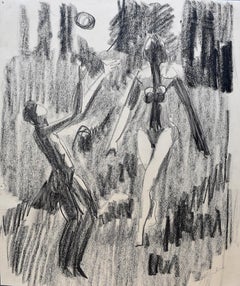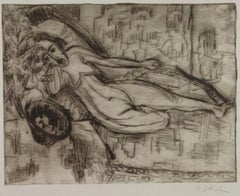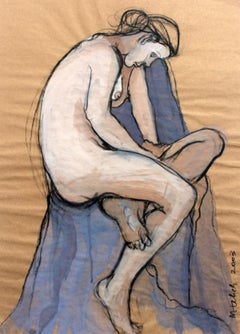Ernst Ludwig Kirchner Art
German, 1880-1938
Ernst Ludwig Kirchner (6 May 1880 – 15 June 1938) was a German expressionist painter and printmaker and one of the founders of the artists group Die Brücke or "The Bridge", a key group leading to the foundation of Expressionism in 20th-century art. He volunteered for army service in the First World War, but soon suffered a breakdown and was discharged. His work was branded as "degenerate" by the Nazis in 1933, and in 1937 more than 600 of his works were sold or destroyed.(Biography provided by Graves International Art)
to
2
1
1
2
1
3
Overall Height
to
Overall Width
to
3
3
2
2
1
1
1
1
1
3
1
1
1
3
6,997
3,373
2,513
1,212
1
1
1
1
Artist: Ernst Ludwig Kirchner
Reclining Young Man - Pencil Drawing - German Expressionism
By Ernst Ludwig Kirchner
Located in London, GB
ERNST LUDWIG KIRCHNER 1880-1938 (German)
Aschaffenburg 1880 - 1938 Davos
Title: Reclining Young Man Liegender junger Mann, circa 1911
Technique: Pencil Drawing on Firm Wove Paper ...
Category
1910s Expressionist Ernst Ludwig Kirchner Art
Materials
Pen
Ball Playing Nudes
By Ernst Ludwig Kirchner
Located in London, GB
ERNST LUDWIG KIRCHNER 1880-1938 (German)
Aschaffenburg 1880 - 1938 Davos
Title: Ball Playing Nudes Ballspielende Akte, 1932
Technique: Chalk Drawing on Smooth Wove Paper
Paper s...
Category
1930s Expressionist Ernst Ludwig Kirchner Art
Materials
Chalk
Nacktes Liegendes Mädchen auf Diwan
By Ernst Ludwig Kirchner
Located in New York, NY
Drypoint printed in dark brown on heavy cream wove paper with wide margins. This is the third state (of four) from a small edition of only several. Signed and inscribed "II Zustand" ...
Category
1920s Expressionist Ernst Ludwig Kirchner Art
Materials
Drypoint, Color
Related Items
Le Pont Neuf
By Lucien Génin
Located in London, GB
'Le Pont Neuf', gouache on fine art paper, by Lucien Génin (circa 1930s). The Pont Neuf is the oldest standing bridge across the river Seine in Paris, France. It stands by the western point of the Île de la Cité, the island in the middle of the river that was, between 250 and 225 BC, the birthplace of Paris. It is called 'The New Bridge' because at the time of its inauguration (built 1578-1607), it embodied a very modern look compared to other bridges which spanned the Seine. Lucien Génin has captured its beauty in this lively depiction from the 1930s. Just before the bridge is a 'Bateau Mouche' an open excursion boat that provides visitors with a view of the city from along the river. The artwork is in good overall condition commensurate with age and medium used. It has been newly frame with anti-reflective glass. Please enjoy the photos accompanying this listing. Signed by the artist in the lower left hand. Upon request a video may be provided.
About the Artist: After the devastation of the First World War, Lucien Génin (1894 - 1953) left his provincial home in the autumn of 1919 to find his fortune among the lively Parisians in the heart of Montmartre. Génin befriended the painters Frank Will, Gen Paul, Émile Boyer, Marcel Leprin...
Category
1930s Expressionist Ernst Ludwig Kirchner Art
Materials
Paper, Gouache
Nude - XXI Century, Contemporary Gouache and Charcoal Figurative Drawing, Female
By Marta Łebek
Located in Warsaw, PL
Marta Lebek is a Polish artist born in 1978. She currently lives and works in Spain.
She studied at the School of Fine Arts and specialized in the departm...
Category
21st Century and Contemporary Expressionist Ernst Ludwig Kirchner Art
Materials
Paper, Charcoal, Gouache
The Drunkard in Spring —after Gustav Mahler's 'The Song of the Earth'
Located in Myrtle Beach, SC
Arthur Paunzen, 'Der Trunkene im Frühling' (The Drunkard in Spring) from the suite 'Song of the Earth', etching, aquatint, and drypoint, 1920. Signed and titled in pencil. Signed in the plate, lower right. A fine, richly-inked impression, on cream, wove Japan paper; the full sheet with margins (2 1/4 to 4 1/4 inches), in good condition. Image size 12 3/8 x 9 1/8 inches; sheet size 19 5/8 x 13 5/8 inches. Matted to museum standards, unframed.
ABOUT THIS WORK
Pauzen’s suite of six etchings 'Das Lied von der Erde' (The Song of the Earth), published in 1920, was inspired by Gustav Mahler...
Category
1920s Vienna Secession Ernst Ludwig Kirchner Art
Materials
Etching, Drypoint, Aquatint
Nude Figure Posterior View, Figurative Drypoint Etching
By Jim Smyth
Located in Soquel, CA
Limited edition drypoint etching of a nude figure from a posterior view by Jim Smyth (American, b. 1938). Numbered and signed by hand "7/15 Jim Smyth" along the bottom edge. Presented in a new cream and off-white double mat. No frame. Image size: 14.75"H x 10.75"W
Jim Smyth (American, b. 1938) has studied at the Academia de Belle Arti in Fiorenza, Italy, Ecole des BeauxArts in Geneva, New York Academy and the Art Students league. He is also a graduate from UC Berkeley with a degree in Fine Art.
Although academically trained, Smyth practices and teaches a more impressionistic style of painting, focusing on Alla Prima technique. He is particularly knowledgeable about drawing, perspective, color theory and the human figure, his passion. Smyth, with an extensive academic knowledge, has a profound love of all human representations as illustrated by his humorous quick sketches from life. He also practices and teaches oil painting and pastels.
When not in Provence, or Southeastern France, Smyth teaches intensely in art schools, art centers and several colleges in the Bay Area. He is a beloved instructor and his classes fill in quickly as he is very knowledgeable.
On his return to the United States, he began studying with Mr. Alanson Appleton at the College of San Mateo, San Mateo, California. Smyth was a founding member of the Appletree Etchers, Inc., an etching print shop organized by Mr. Appleton and his students to develop and promote color intaglio. Smyth served as Master Printer at the studio for many years perfecting the techniques of intaglio and developing the color theories of Mr. Appleton as applied to the deep etched plate.
Smyth received his degree from the University of California, Berkeley, in 1972 and holds the California Community College Certificate and an Adult Education Certificate. Smyth was invited to teach "Anatomy for Artists" at Foothill College, Los Altos Hills, California, as a result of his many years of dissection of the cadaver and developed the course of study of Perspective for the college. During this period, he began teaching Life Drawing at the Pacific Art League of Palo Alto, Palo Alto, California. During the following thirty years Smyth has taught an average of twelve classes per week at the Pacific Art League of Palo Alto, the Palo Alto Art Center and the Burlingame Recreation Department among others in all phases of drawing and painting. He has conducted many workshops for the California Academy of Painters in many aspects of drawing and painting. Currently, he is an Adjunct Professor of Drawing at the College of San Mateo, San Mateo, California. He is an authority on the materials of painting and drawing, techniques of traditional drawing and painting, color theory, perspective and anatomy for artists. In his career in Life Drawing, Smyth has made over two hundred thousand drawings from the model.
In addition to studies at Berkeley, Smyth has studied at the College of San Mateo, Foothill College, De Anza College, Mission College and West Valley College, all in California. One of the pivotal points in his career was studying with Mr. Maynard Dixon Stewart at the University of San Jose, California. He spent a year at the New York Academy of Art where he was offered a full scholarship and at the Art Students League of New York. He concurrently attended classes at the National Academy of Design in New York. Among others, Smyth studied with M. Andrejivec, Ted Schmidt, Elliot Goldfinger, Gary Fagin, Ted Jacobs, Leo Neufeld, David Leffel, Jack Ferragasso, Jim Childs and Everett Raymond Kinstler and Kim English. Smyth has also studied with the noted painter and colorist, Ovanes Berberian. In 2002 Jim was invited to study at the Academy of Art in St. Petersburg, Russia, where he worked in Life Drawing and Life Painting.
Smyth is a popular lecturer, a sought after demonstrator and juror. He is the recipient of many awards for both his painting and his teaching. In 1988 and again in 2003, he received the Kenneth Washburn...
Category
Late 20th Century American Impressionist Ernst Ludwig Kirchner Art
Materials
Paper, Ink, Drypoint
H 16 in W 12 in D 0.07 in
Large Israeli Watercolor Gouache Painting Jerusalem Landscape Moshe Gat
By Moshe Gat
Located in Surfside, FL
A signed watercolor gouache painting in frame.
Framed: 26.5 X 32.5
Image: 19 X 25
Moshe Gat was born in Haifa in 1935.
in 1952 he began his studies at the Bezalel School, in Jeru...
Category
Mid-20th Century Expressionist Ernst Ludwig Kirchner Art
Materials
Watercolor, Gouache
347 Series (B. 1511; Ba. 1527), Pablo Picasso
By Pablo Picasso
Located in Fairfield, CT
Artist: Pablo Picasso (1881-1973)
Title: Jeune fille regardée par une vielle femme et deux hommes dont un gitan
Year: 1968
Medium: Etching, aquatint and drypoint on Rives BFK paper
Size: 12.5 x 18.5 (plate); 17.75 x 24.25 inches (paper); 20.25 x 30.25 inches (frame)
Condition: Excellent
Catalogue: B. 1511; Ba. 1527
Inscription: Signed and numbered in pencil
Notes: Published by Galerie Louise Leiris, Paris, from the 347 Series.
PABLO PICASSO (1881-1973) Spanish painter and sculptor is one of the most recognized figures of twentieth century art. During his artistic career, which lasted more than 75 years, he created thousands of works using all kinds of mediums. He changed art more profoundly than any other artist of his time. First famous for pioneering cubism, Picasso continued to develop his art with a pace and vitality comparable to the accelerated technological and cultural changes of the twentieth century. Each change embodied a radical idea, and might be said that Picasso lived several artistic lifetimes.
ABOUT SELLER
DO YOU HAVE ARTWORK TO SELL? WE ARE ACTIVELY SEEKING CONSIGNMENTS AND EXCEPTIONAL OBJECTS TO PURCHASE OUTRIGHT!
Art Commerce...
Category
1960s Cubist Ernst Ludwig Kirchner Art
Materials
Drypoint, Etching, Aquatint
Untitled, 1971
By Pablo Picasso
Located in Wien, 9
- Plate 118 from the Suite 156
- edition 48/50
- stamp signature
- dated in the plate 17.5.71
- cat. raisonné Bloch 1973; cat. raisonné Baer 1982
Category
1970s Modern Ernst Ludwig Kirchner Art
Materials
Etching, Drypoint
Abstract Expressionist Portrait of a Man in a Suit in Pastel on Paper Bay Area
Located in Soquel, CA
Expressionist Portrait of a Man in a Suit in Pastel on Paper
Moody portrait of a man with dark hair by an unknown artist (20th Century). The man is shown with an elongated face and ...
Category
Late 20th Century Expressionist Ernst Ludwig Kirchner Art
Materials
Paper, Oil Pastel
H 20 in W 16 in D 0.75 in
Resurrection (aka Flying Figures; Border of the Lake)
By Arthur B. Davies
Located in New York, NY
Arthur B. Davies (1862-1928), Resurrection (aka Flying Figures; Border of the Lake), drypoint and aquatint on zinc, 1916, signed with the estate stamp lower right. Reference: Price 2...
Category
1910s American Impressionist Ernst Ludwig Kirchner Art
Materials
Drypoint, Aquatint
UNTITLED (FROM EIGHT LITTLE NUDES)
By Jim Dine
Located in Aventura, FL
Hand signed, numbered and dated by the artist. From Eight Little Nudes (D'Oench & Feinberg 123-30). Etching with drypoint and aquatint in colors on BFK Rives. Published by Pace Editi...
Category
1980s Pop Art Ernst Ludwig Kirchner Art
Materials
Drypoint, Paper, Etching, Aquatint
The Little Model - Original Drypoint by Lino Selvatico - 1910
By Lino Selvatico
Located in Roma, IT
Hand signed.
Includes passepartout (cm. 53x37).
Lino Selvatico was an Italian painter. The elegance of his portraits is close to the atmosphere of the Post-Impressionism.
This artwo...
Category
1910s Ernst Ludwig Kirchner Art
Materials
Etching, Drypoint
H 16.34 in W 11.03 in D 0.04 in
Original German Expressionist Drawing Ernst Ludwig Kirchner Women Dancing
By Ernst Ludwig Kirchner
Located in Surfside, FL
Ernst Ludwig Kirchner ( Germany 1880-1938 )
Expressionist Female Women Dancing Mixed Media on Paper Drawing or Painting Expressionism
Dimensions: 20" L 16" H in
This bore a sticker from Christies auction house and another collection sticker verso but they have been inadvertently removed. I do have the photo.
Ernst Ludwig Kirchner (1880 – 1938) was a German expressionist painter and printmaker and one of the founders of the artists group Die Brücke or "The Bridge", a key group leading to the foundation of Expressionism in 20th-century art. He volunteered for army service in the First World War, but soon suffered a breakdown and was discharged. His work was branded as "Entartete Kunst" or "degenerate" by the Nazis in 1933, and in 1937 more than 600 of his works were sold or destroyed.
Ernst Ludwig Kirchner was born in Aschaffenburg, Bavaria. His parents were of Prussian descent and his mother was a descendant of the Huguenots, a fact to which Kirchner often referred. As Kirchner's father searched for a job, the family moved frequently and Kirchner attended schools in Frankfurt and Perlen until his father earned the position of Professor of Paper Sciences at the College of technology in Chemnitz, where Kirchner attended secondary school. Although Kirchner's parents encouraged his artistic career they also wanted him to complete his formal education so in 1901, he began studying architecture at the Königliche Technische Hochschule (royal technical university) of Dresden. The institution provided a wide range of studies in addition to architecture, such as freehand drawing, perspective drawing and the historical study of art. While in attendance, he became close friends with Fritz Bleyl, whom Kirchner met during the first term. They discussed art together and also studied nature, having a radical outlook in common. Kirchner continued studies in Munich from 1903 to 1904, returning to Dresden in 1905 to complete his degree.
In 1905, Kirchner, along with Bleyl and two other architecture students, Karl Schmidt-Rottluff and Erich Heckel, founded the artists group Die Brücke ("The Bridge") later to include Emil Nolde, Max Pechstein and Otto Mueller. From then on, he committed himself to art. The group aimed to eschew the prevalent traditional academic style and find a new mode of artistic expression, which would form a bridge (hence the name) between the past and the present. They responded both to past artists such as Albrecht Dürer, Matthias Grünewald and Lucas Cranach the Elder, as well as contemporary international avant-garde movements. As part of the affirmation of their national heritage, they revived older media, particularly woodcut or woodblock prints.
Kirchner's studio became a venue which overthrew social conventions to allow casual love-making and frequent nudity. Group life-drawing sessions took place using nude models from the social circle, rather than professionals, and choosing quarter-hour poses to encourage spontaneity. In 1911, he moved to Berlin, where he founded a private art school, MIUM-Institut, in collaboration with Max Pechstein with the aim of promulgating "Moderner Unterricht im Malen" (modern teaching of painting). This was not a success and closed the following year, when he also began a relationship with Erna Schilling that lasted the rest of his life. In 1917, at the suggestion of Eberhard Grisebach [de], Helene Spengler invited Kirchner to Davos where he viewed an exhibition of Ferdinand Hodler paintings. "When I was leaving, I thought of Vincent Van Gogh's fate and thought that it would be his as well, sooner or later. Only later will people understand and see how much he has contributed to painting".
In 1921 Kirchner visited Zurich at the beginning of May and met the dancer, Nina Hard, whom he invited back to Frauenkirch (despite Erna's objections). Nina Hard would become an important model for Kirchner and would be featured in many of his works. Kirchner began creating designs for carpets which were then woven by Lise Gujer.
In 1925, Kirchner became close friends with fellow artist, Albert Müller...
Category
Early 20th Century Expressionist Ernst Ludwig Kirchner Art
Materials
Ink, Paper
Ernst Ludwig Kirchner art for sale on 1stDibs.
Find a wide variety of authentic Ernst Ludwig Kirchner art available for sale on 1stDibs. You can also browse by medium to find art by Ernst Ludwig Kirchner in chalk, drypoint, engraving and more. Much of the original work by this artist or collective was created during the 20th century and is mostly associated with the Expressionist style. Not every interior allows for large Ernst Ludwig Kirchner art, so small editions measuring 7 inches across are available. Customers who are interested in this artist might also find the work of Béla Kádár, Max Liebermann, and Merton Clivette. Ernst Ludwig Kirchner art prices can differ depending upon medium, time period and other attributes. On 1stDibs, the price for these items starts at $13,300 and tops out at $40,000, while the average work can sell for $22,000.



